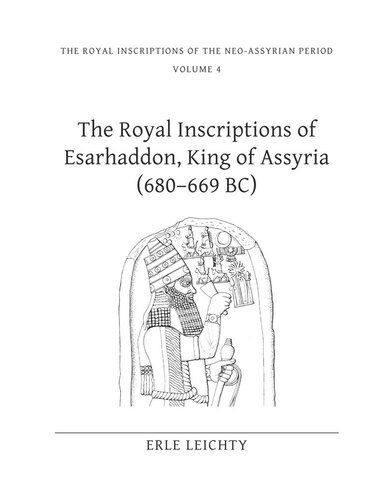

Most ebook files are in PDF format, so you can easily read them using various software such as Foxit Reader or directly on the Google Chrome browser.
Some ebook files are released by publishers in other formats such as .awz, .mobi, .epub, .fb2, etc. You may need to install specific software to read these formats on mobile/PC, such as Calibre.
Please read the tutorial at this link: https://ebookbell.com/faq
We offer FREE conversion to the popular formats you request; however, this may take some time. Therefore, right after payment, please email us, and we will try to provide the service as quickly as possible.
For some exceptional file formats or broken links (if any), please refrain from opening any disputes. Instead, email us first, and we will try to assist within a maximum of 6 hours.
EbookBell Team

5.0
88 reviewsThe Royal Inscription of Esarhaddon, King of Assyria (680–669 BC) is the inaugural volume of the Royal Inscriptions of the Neo-Assyrian Period Project. The volume provides reliable, up-to-date editions of all of the known royal inscriptions of Esarhaddon, a son of Sennacherib who ruled Assyria for twelve years (680–669 BC). Editions of 143 firmly identifiable texts (which mostly describe successful battles and the completion of building projects, all done ad maiorem gloriam deorum), 29 poorly preserved late Neo-Assyrian inscriptions that may be attributed to him, and 10 inscriptions commissioned by his mother Naqia (Zakutu) and his wife Esharra-hammat are included. To make this corpus more user-friendly to both specialist and laymen, each text edition (with its English translation) is supplied with a brief introduction containing general information, a catalogue containing basic information about all exemplars, a commentary containing further technical information and notes, and a comprehensive bibliography (arranged chronologically from earliest to latest).
The volume also includes: (1) a general introduction to the reign of Esarhaddon, the corpus of inscriptions, previous studies, and dating and chronology; (2) translations of the relevant passages of three Mesopotamian chronicles; (3) 19 photographs of objects inscribed with texts of Esarhaddon; (4) indexes of museum and excavation numbers and selected publications; and (5) indexes of proper names (Personal Names; Geographic, Ethnic, and Tribal Names; Divine, Planet, and Star Names; Gate, Palace, Temple, and Wall Names; and Object Names). The book is accompanied by a CD-ROM containing transliterations of selected inscriptions arranged in a ‘musical score’ format.
The Royal Inscriptions of the Neo-Assyrian Period (RINAP) series will present up-to-date editions of the royal inscriptions of a number of late Neo-Assyrian rulers, beginning with Tiglath-pileser III (744–727 BC). This new series is modeled on the publications of the now-defunct Royal Inscriptions of Mesopotamia (RIM) series and will carry on where its RIMA (Royal Inscriptions of Mesopotamia, Assyrian Periods) publications ended. The project is under the direction of G. Frame (University of Pennsylvania) and is supported by the National Endowment for the Humanities.